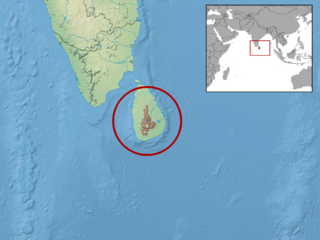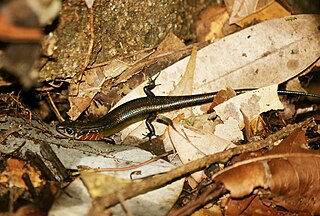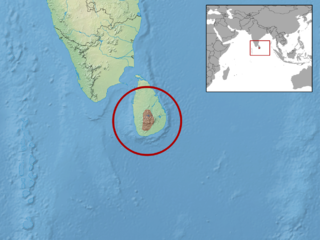Nessia is a genus of skinks, lizards in the family Scincidae. The genus is endemic to Sri Lanka. Species in the genus Nessia are commonly known as snake skinks.
The Haly's tree skink is a species of lizard in the family Scincidae. The species is native to Sri Lanka. Earlier thought to be found also in the Western Ghats, taxonomic studies have shown D. haliana to be a Sri Lankan endemic, differentiated from the Indian D. subcaeruleum. D. haliana is the only arboreal skink in Sri Lanka.

Eutropis bibronii, also known commonly as Bibron's mabuya, Bibron's skink, and the seashore skink, is a species of lizard in the family Scincidae. The species is native to India and Sri Lanka.

Sphenomorphus dussumieri, commonly known as Dussumier's forest skink and Dussumier's litter skink, is a species of skink, a lizard in the family Scincidae. The species is endemic to southern India.
Ceratophora karu, also known commonly as Karu's horned lizard or Karunaratne's horn lizard, is a species of lizard in the family Agamidae. The species is endemic to Sri Lanka.
Thwaites's skink, also known commonly as the fourtoe snakeskink, is a species of skink, a lizard in the family Scincidae. The species is endemic to the island of Sri Lanka.

Lankascincus deignani, commonly known as Deignan's tree skink and the Deignan tree skink, is a species of lizard in the family Scincidae. The species is endemic to the island of Sri Lanka.

Lankascincus gansi, also commonly known as Gans's lankaskink and Gans's tree skink, is a species of lizard in the family Scincidae. The species is endemic to the island of Sri Lanka.

Lankascincus taprobanensis, also known commonly as the Ceylon tree skink and the smooth Lanka skink, is a species of lizard in the family Scincidae. The species is endemic to the island of Sri Lanka.
Lankascincus taylori, commonly known as Taylor's tree skink, is a species of lizard in the family Scincidae. The species is endemic to the island of Sri Lanka.
Lankascincus dorsicatenatus, also known as the catenated lankaskink, is a species of skink, a lizard in the family Scincidae. The species is endemic to island of Sri Lanka.
Eutropis floweri, also known commonly as Flower's skink, Taylor's skink and Taylor's striped mabuya, is a species of lizard in the family Scincidae. The species is endemic to the island of Sri Lanka. It is probably named after Stanley Smyth Flower.
Eutropis madaraszi, also known commonly as the Sri Lanka bronze mabuya, the Sri Lanka bronze skink, or (ambiguously) the spotted skink, is a species of lizard in the family Scincidae. The species is endemic to the island of Sri Lanka.
Nessia burtonii, commonly known as Burton's nessia, Gray's snake skink, or the three-toed snakeskink, is a species of skink, a lizard in the family Scincidae. The species is endemic to the island of Sri Lanka.
Nessia deraniyagalai, commonly known as Deraniyagala's snake skink, Deraniyagala's snakeskink, or Deraniyagala's nessia, is a species of limbless lizard in the family Scincidae. The species is endemic to the island of Sri Lanka.
Nessia hickanala, also known as the shark-headed snake skink and Hickanala nessia, is a species of skink endemic to island of Sri Lanka.
Nessia layardi, commonly known as Layard's snake skink or Layard's nessia, is a species of lizard in the subfamily Scincinae of the family Scincidae. The species is endemic to the island of Sri Lanka.
Nessia sarasinorum, commonly known as Sarasins's snake skink or Müller's nessia, is a species of lizard in the family Scincidae. The species is endemic to the island of Sri Lanka.
Nessia gansi, also known commonly as Gans's three-toed snake skink, is a species of lizard in the family Scincidae. The species is endemic to the island of Sri Lanka.





